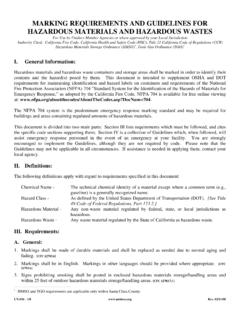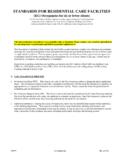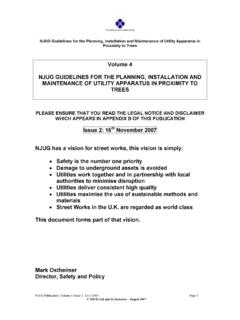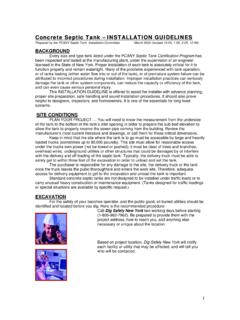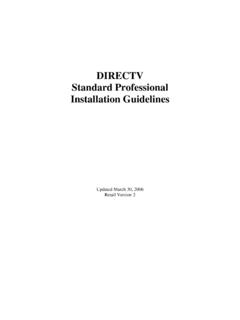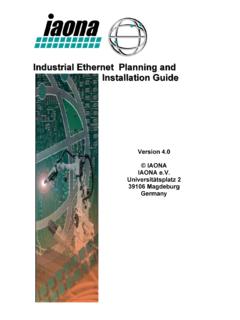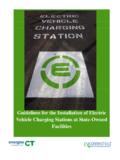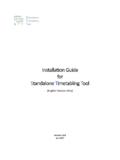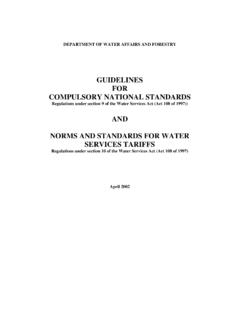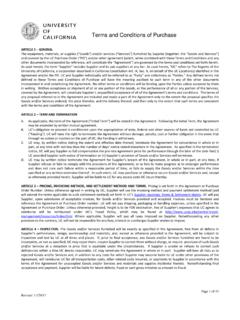Transcription of Unidocs Guidelines for Installation of …
1 UN-018 1/7 - Rev. 03/12/15 Guidelines FOR Installation OF TEMPORARY AND PERMANENT aboveground DIESEL FUEL TANKS FOR EMERGENCY AND STANDBY POWER SYSTEMS LOCATED OUTSIDE OF BUILDINGS For Use by Unidocs Member Agencies or where approved by your Local Jurisdiction Authority cited: California Fire Code; National Fire Protection Association 30 (NFPA) Flammable and Combustible Liquids Code; Local Hazardous Materials Storage Ordinances (Check with Authority Having Jurisdiction) I. General Information These Guidelines are applicable to the Installation of aboveground tanks using combustible liquids as fuel for emergency and standby generators. They apply to both temporary and permanent tank installations. These Guidelines are a supplement to other requirements and/or Guidelines , and are not all-inclusive. II. Permits and Plans An Installation permit is usually required from your local Planning and/or Building Department to install an emergency or standby generator tank, piping, and associated equipment; A new or modified Hazardous Materials Business Plan (HMBP) is required before placing the tank(s) in service; Notification of the electric utility is required; Permits may also be required from your local Air Quality Management District or Air Pollution Control District.
2 III. Definitions The following definitions apply with regard to requirements specified in this document: Temporary Tank A tank which is on-site no longer than one (1) year. IV. Quantity Limits Many cities and counties have adopted specific prohibitions or limitations to the sizes of unprotected and protected aboveground storage tanks. Please contact the local fire authority having jurisdiction (AHJ) for any potential aboveground storage tank amendments their community may have made when adopting the California Fire Code. A. Tanks 1. Design and Construction: Each tank shall be designed and constructed in accordance with nationally recognized standards (UL 142 or equivalent. UL 2085 is the listing for protected tanks). If it is not UL listed, provide documentation showing that it has been designed and constructed to that standard.
3 [CFC & NFPA 30 ] 2. Location of Tanks: aboveground tanks shall be located in accordance with Table (a) of NFPA 30, below. [CFC ] Guidelines for Installation of aboveground Fuel Tanks for Emergency Power- Page 2 of 7 UN-018 2/7 - Rev. 03/12/15 [Note: Many cities and counties have adopted more stringent separation distances for unprotected and protected aboveground storage tanks. Please contact the fire agency having jurisdiction for any potential amendments pertaining to separation distances their community may have made when adopting the California Fire Code.] NFPA 30 Table (a) Type of Tank Protection Minimum distance from property line that is or can be built upon, including the opposite side of a public way (feet)1 Minimum distance from nearest side of any public way or from nearest important building on the same property (feet)1 Horizontal and vertical tanks with emergency relief devices to limit pressures to Protection for exposures2 Table (b) value Table (b) value None 2 x Table (b) value Table (b) value Protected aboveground tank None Table (b) value Table (b) value 1.
4 The minimum distance shall not be less than five (5) feet. 2. If a public fire department (or a private fire brigade maintained on the premises) is not available to provide cooling water streams to protect the property adjacent to the liquid storage, the distance shall be doubled. NFPA 30 Table (b) Reference Table for Use in (a) Tank Capacity (gallons) Minimum distance from property line that is or can be built upon, including the opposite side of a public way (feet)Minimum distance from nearest side of any public way or from nearest important building on the same property (feet)275 or less 5 5 276 to 750 10 5 751 to 12,000 15 5 12,001 to 30,000 20 5 3. Supports, Foundations, and Anchorage: Supports, foundations, and anchorage for aboveground tanks shall be designed and constructed in accordance with NFPA 30 and the California Fire Code. [CFC ; NFPA 30 & ] [Exception: For temporary tanks, wheels may be chocked in lieu of providing seismic protection.]
5 ] 4. Protection from Vehicles: Guard posts or other approved means shall be provided to protect tanks subject to vehicular damage in accordance with CFC 312. When guard posts are installed, posts shall be: [CFC & ] a. Constructed of steel not less than 4 inches in diameter and concrete filled; b. Spaced not more than 4 feet between posts on center; c. Set not less than 3 feet deep in a concrete footing of not less than 15 inches in diameter; d. Set with the top of the posts not less than 3 feet aboveground ; e. Located not less than 3 feet from the protected object. [Exception: This does not apply to protected aboveground tanks having the impact protection incorporated into the system design in compliance with the impact test protocol of UL 2085.] [CFC ] Guidelines for Installation of aboveground Fuel Tanks for Emergency Power- Page 3 of 7 UN-018 3/7 - Rev. 03/12/15 [Note: For temporary tanks, other approved physical barriers that comply with CFC may be used in lieu of guard posts.
6 ] 5. Secondary Containment Protected Tanks: Protected tanks shall be provided with secondary containment, drainage control, or diking in accordance with CFC A means shall be provided to establish the integrity of the secondary containment in accordance with NFPA 30. [CFC ] 6. Secondary Containment Unprotected Tanks: Tanks shall be provided with secondary containment ( , containment external to and separate from primary containment). Secondary containment shall be constructed of materials of sufficient thickness, density, and composition so as not to be structurally weakened as a result of contact with the fuel stored and capable of containing discharged fuel for a period of time equal to or longer than the maximum anticipated time sufficient to allow recovery of discharged fuel. It shall be capable of containing 110% of the volume of the primary tank if a single tank is used, or in the case of multiple tanks, 150% of the largest tank or 10% of the aggregate, whichever is larger.
7 If secondary containment is open to rainfall or sprinkler flow, contact the local jurisdiction for appropriate calculations. [Local Ordinances Check with local Authority Having Jurisdiction] 7. Spill Containers: Where required for unprotected tanks, spill containers shall be provided on top-filling and/or top-withdrawal connections. Spill containers shall be non-combustible and shall be fixed to the tank. [Local Ordinances Check with local Authority Having Jurisdiction] For protected tanks, spill containers of not less than 5 gallons shall be provided for each fill connection. Spill containers shall be non-combustible, and shall be fixed to the tank and equipped with a manual valve drain to the primary tank. For tanks with a remote fill connection, a portable spill container shall be allowed. [CFC ] 8. Overfill Prevention: Unprotected tanks with capacities greater than 1,320 gallons, and protected tanks with any capacity shall be provided with equipment to prevent overfilling as per the following table: [CFC ; NFPA 30 ; Local Ordinances Check with local Authority Having Jurisdiction] Physical Situation Approved Overfill Methods At 90% of Tank Capacity Audible or visual signal to notify tank filler; Or Tank level gauge marked at 90% of tank capacity; Or Other approved means.
8 ANDAt 95% of Tank Capacity Automatically shut off the flow of fuel to the , in Lieu of the above two items:N/A The system shall: 1.) Reduce the flow rate to not more than 15 gallons per minute so that at the reduced flow rate the tank will not overfill for at least 30 minutes, and 2.) Automatically shut off the flow into the tank prior to any tank top fittings being exposed to product. [Note: Many cities and counties have adopted overfill prevention requirements that are stricter than the Fire Code requirements identified above ( , requiring overfill prevention for any size unprotected tank).] [Local Ordinances Check with local Authority Having Jurisdiction] Guidelines for Installation of aboveground Fuel Tanks for Emergency Power- Page 4 of 7 UN-018 4/7 - Rev. 03/12/15 Information Signs for Protected Tanks A permanent sign shall be provided at the fill point documenting the filling procedure and tank calibration chart.
9 The filling procedure shall require the person filling the tank to note the gallonage currently in the tank and determine the additional gallonage required to fill the tank to 90% of capacity before commencing the fill operation. [CFC & ] B. Piping Systems 1. Piping Support: Piping systems shall be substantially supported and protected against physical damage and excessive stresses arising from settlement, vibration, expansion or contraction, or exposure to fire. [CFC ] 2. Seismic Protection: Seismic protection for piping and connections shall be provided in accordance with the Uniform Building Code. [CFC ] [Exception: Not normally required for temporary piping.] 3. Special Materials: For primary piping, low melting point materials (such as aluminum, copper, and brass), materials which soften on fire exposure (such as non-metallic materials), or non-ductile materials (such as cast iron), shall be in accordance with American Society of Mechanical Engineers (ASME) Building Services Piping Code for Pressure Piping and shall be either: [CFC ; NFPA & ] a.
10 Suitably protected against fire exposure; or b. Located such that leakage resulting from failure would not unduly expose persons, buildings, or structures; or c. Located where leakage can readily be controlled by operation of accessible remotely-located valves. 4. Protection from Vehicles: Guard posts or other approved means shall be provided to protect piping, valves or fittings subject to vehicular damage in accordance with CFC 312. When installed, posts shall be: [CFC 312 & ] a. Constructed of steel not less than 4 inches in diameter and concrete filled; b. Spaced not more than 4 feet between posts on center; c. Set not less than 3 feet deep in a concrete footing of not less than 15 inches in diameter; d. Set with the top of the posts not less than 3 feet aboveground ; e. Located not less than 3 feet from the protected object. [Note: For temporary piping systems, other approved physical barriers that comply with CFC may be used in lieu of guard posts.]

